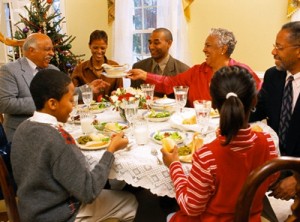Over the last 15 years, a large number of scientific studies have confirmed what parents have known intuitively for a long time: sitting down to a family meal is good for the spirit, the brain, and the body.
Recent studies link regular family dinners (5 or more meals a week) with a host of teenage behaviors that parents pray for: lower rates of substance abuse, teen pregnancy, and depression. And higher grade-point averages and self-esteem. Dinner conversation is a great booster of vocabulary for young children, and stories told around the table about parents and grandparents help to build self-esteem and resilience. The icing on the cake is that regular family meals also lower the rates of obesity and eating disorders in children.

1. You can tell a lot about your family from your dinnertime ritual.
Who decides the menu, and what happens if someone doesn’t like the meal? What do you talk about at dinner? Are there topics or emotions that are taboo? What is the symbolic meaning given to food? Who shops, cooks, serves, cleans up? And what do these roles say about your family’s ideas about gender roles? How is dinnertime protected from technology, like texting at the table, answering the phone, watching TV? What did you want to carry forward from the family you grew up in? It helps to reinforce family values and culture.
2. Family dinner can be playful
Mealtime is to families what intimacy is to couples, what music is to adolescents, and what water and sand are to toddlers. Mealtime is a medium of play – a way for families to have pleasure with one another. You might ask: “What would make dinnertime more fun?”
Ask everyone in the family what they think. And how to make dinner time more fun and engaging.
Ask everyone in the family what they think. And how to make dinner time more fun and engaging. Share on X3. Change the routine as your children grow
Life is in stages. Your child’s appetite, ability to cook, and readiness to participate in dinner conversation; will all change dramatically from infancy through young adulthood.
When you have toddlers, that is a critical time to start regular family dinners. Serve food family-style in bowls that youngsters can reach out and try. At this age it is important for your toddlers to see you eating all types of nutritious food enthusiastically. Don’t use reward or punishment to encourage eating. Also keep in mind that toddlers may need up to 15 presentations of the same food before they try it.
Any child who “helps” to make dinner is more likely to want to try it. The whole process of mixing, stirring, and making a mess fascinates young children, so let them stir the soup and crumble the cheese.
As your children become school-aged, they are learning to share and compromise. As they become more aware of the world around them through watching TV and visiting other children’s houses, they may want to experiment with new foods. It can be fun to recreate foods they’ve eaten elsewhere, like making pizza or tacos.
During adolescence, family dinners tend to decrease, although most teens will concede that they enjoy having dinner at home. The dinner hour may need to be more flexible to accommodate everyone’s schedule and plans. But perhaps there can be rules in place to insist on dinner at a certain time no matter what? But note then you have to comply as parents.
Since adolescence is a time of exploration and separation, your teens may declare that they have food preferences that are unlike yours.
4. Pay attention to table conversation
Talk at the table is one of the best experiences of your child’s life. When else besides around the table (or in therapy) do we sit and talk for several minutes, with family members offering lots of different comments on one topic?
Make sure that the quieter members can speak without interruptions. Add variety to table talk – not only what you did at school today, but also talk about the food, and about funny, and courageous stories about other family members.
Dinner is also a time to talk about plans for the future, current affairs, friendships, wins and challenges from the day and anything else that comes up.
How do you get your family to eat together? Especially here in Lagos, with the busy schedules and traffic? Are you able to sit together?
source PBS.org: contributed by Anne K. Fishel, Ph.D. is a therapist, professor of psychology[poll id=”14″]


